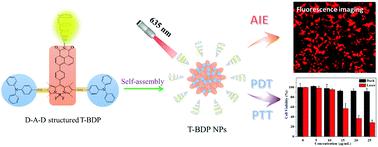当前位置:
X-MOL 学术
›
Mater. Chem. Front.
›
论文详情
Our official English website, www.x-mol.net, welcomes your feedback! (Note: you will need to create a separate account there.)
Small organic molecule-based nanoparticles with red/near-infrared aggregation-induced emission for bioimaging and PDT/PTT synergistic therapy
Materials Chemistry Frontiers ( IF 7 ) Pub Date : 2020-09-29 , DOI: 10.1039/d0qm00536c Mengqian Yang 1, 2, 3, 4, 5 , Jingran Deng 1, 2, 3, 4, 5 , Huifang Su 5, 6, 7, 8 , Shuangxi Gu 1, 2, 3, 4, 5 , Jie Zhang 5, 9, 10, 11 , Aiguo Zhong 5, 9, 10, 11 , Fengshou Wu 1, 2, 3, 4, 5
Materials Chemistry Frontiers ( IF 7 ) Pub Date : 2020-09-29 , DOI: 10.1039/d0qm00536c Mengqian Yang 1, 2, 3, 4, 5 , Jingran Deng 1, 2, 3, 4, 5 , Huifang Su 5, 6, 7, 8 , Shuangxi Gu 1, 2, 3, 4, 5 , Jie Zhang 5, 9, 10, 11 , Aiguo Zhong 5, 9, 10, 11 , Fengshou Wu 1, 2, 3, 4, 5
Affiliation

|
Organic nanomaterials with efficient ROS generation and high photothermal conversion efficiency have emerged as a new generation therapeutic agent for PDT/PTT synergistic cancer treatment. However, most of the organic nanomaterials exhibited weak emission in water because of the aggregation-caused quenching (ACQ) effect, which seriously hampers their biological application in fluorescence bioimaging. In this study, we design and synthesize a new organic small molecule (T-BDP) with a donor–acceptor–donor (D–A–D) structure by the conjugation of boron-dipyrromethene (BODIPY) and triphenylamine (TPA). Moreover, a 1,8-naphthalenediimide (NI) structure with electron-withdrawing ability is introduced onto the core of BODIPY to further enhance the intramolecular charge transfer, leading to the redshift of absorption to the near-infrared region. T-BDP displays significant aggregation-induced emission (AIE) performance, probably due to the presence of two twisted TPA groups onto the BODIPY core. Accordingly, after self-assembly into nanoparticles, T-BDP NPs exhibit strong near-infrared emission in water. Under single 635 nm laser irradiation, T-BDP NPs could generate reactive oxygen species and heat simultaneously. The photothermal conversion efficiency of T-BDP NPs is determined to be 50.9%. The low dark toxicity and high photocytotoxicity of T-BDP NPs are verified against A549 cells using the MTT assay and the AM/PI staining method. Due to the strong emission of T-BDP NPs, their accumulation and subcellular localization in cancer cells are observed using a laser confocal fluorescence microscope. The results demonstrate that T-BDP NPs are mainly located in the lysosomes of cancer cells. Thus, the as-prepared small molecule-based AIE nanoparticles hold great potential for fluorescence imaging-guided PDT/PTT synergistic tumor therapy.
中文翻译:

具有红色/近红外聚集诱导发射的有机小分子纳米颗粒,用于生物成像和PDT / PTT协同治疗
具有高效活性氧生成和高光热转化效率的有机纳米材料已经成为用于PDT / PTT协同癌症治疗的新一代治疗剂。然而,由于聚集引起的猝灭(ACQ)效应,大多数有机纳米材料在水中均表现出微弱的发射,这严重阻碍了它们在荧光生物成像中的生物学应用。在这项研究中,我们设计并合成了一种新的有机小分子(T-BDP),通过将硼二吡咯亚甲基(BODIPY)和三苯胺(TPA)结合在一起形成施主-受主-施主(DA-D)结构。此外,将具有吸电子能力的1,8-萘二酰亚胺(NI)结构引入BODIPY的核中,以进一步增强分子内电荷转移,从而导致吸收红移至近红外区域。T-BDP显示出显着的聚集诱导发射(AIE)性能,这可能是由于BODIPY核心上存在两个扭曲的TPA基团。因此,在自组装成纳米颗粒之后,T-BDP NP在水中表现出很强的近红外发射。在单635 nm激光照射下,T-BDP NP会同时产生活性氧和热量。T-BDP NP的光热转化效率确定为50.9%。使用MTT测定法和AM / PI染色方法验证了T-BDP NPs对A549细胞的低暗毒性和高光细胞毒性。由于T-BDP NP的强烈发射,使用激光共聚焦荧光显微镜观察了它们在癌细胞中的积累和亚细胞定位。结果表明,T-BDP NPs主要位于癌细胞的溶酶体中。因此,所制备的基于小分子的AIE纳米粒子在荧光成像引导的PDT / PTT协同肿瘤治疗中具有巨大的潜力。
更新日期:2020-11-03
中文翻译:

具有红色/近红外聚集诱导发射的有机小分子纳米颗粒,用于生物成像和PDT / PTT协同治疗
具有高效活性氧生成和高光热转化效率的有机纳米材料已经成为用于PDT / PTT协同癌症治疗的新一代治疗剂。然而,由于聚集引起的猝灭(ACQ)效应,大多数有机纳米材料在水中均表现出微弱的发射,这严重阻碍了它们在荧光生物成像中的生物学应用。在这项研究中,我们设计并合成了一种新的有机小分子(T-BDP),通过将硼二吡咯亚甲基(BODIPY)和三苯胺(TPA)结合在一起形成施主-受主-施主(DA-D)结构。此外,将具有吸电子能力的1,8-萘二酰亚胺(NI)结构引入BODIPY的核中,以进一步增强分子内电荷转移,从而导致吸收红移至近红外区域。T-BDP显示出显着的聚集诱导发射(AIE)性能,这可能是由于BODIPY核心上存在两个扭曲的TPA基团。因此,在自组装成纳米颗粒之后,T-BDP NP在水中表现出很强的近红外发射。在单635 nm激光照射下,T-BDP NP会同时产生活性氧和热量。T-BDP NP的光热转化效率确定为50.9%。使用MTT测定法和AM / PI染色方法验证了T-BDP NPs对A549细胞的低暗毒性和高光细胞毒性。由于T-BDP NP的强烈发射,使用激光共聚焦荧光显微镜观察了它们在癌细胞中的积累和亚细胞定位。结果表明,T-BDP NPs主要位于癌细胞的溶酶体中。因此,所制备的基于小分子的AIE纳米粒子在荧光成像引导的PDT / PTT协同肿瘤治疗中具有巨大的潜力。


























 京公网安备 11010802027423号
京公网安备 11010802027423号